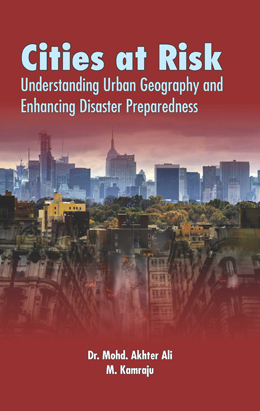
ISBN : 978-93-91139-73-5
Edition : Hard Bound
Categories : Geography
Delivered 2-5 Business Days
Easy Returns and Replacement
Payment Options : (Credit Card , Debit Card , Net Banking)
“Cities at Risk: Understanding Urban Geography and Enhancing Disaster Preparedness” is a comprehensive book that focuses on the critical relationship between urban geography and disaster preparedness. The book delves into the complex dynamics of urban areas and how they influence disaster risk, vulnerability, and resilience. It provides insights into the challenges posed by rapid urbanization and how it can exacerbate disaster vulnerabilities.
The book is divided into several chapters, each exploring different aspects of urban geography and disaster management. It begins with an introduction that emphasizes the importance of understanding urban geography in the context of disaster preparedness. From there, it covers topics such as the spatial distribution of risks in urban areas, identifying vulnerable populations and infrastructure, and techniques for mapping vulnerabilities and risk hotspots.
The role of interconnected urban systems, such as transportation, energy, water, and communication, in disaster resilience is thoroughly explored. The book highlights the significance of social networks and community resilience in disaster management and how adaptive capacity can be enhanced to cope with unpredictable and changing conditions.
Urban planning and design play a pivotal role in disaster resilience, and the book emphasizes the integration of disaster risk reduction into urban planning processes. It outlines principles of resilient urban design and advocates for the incorporation of green infrastructure to mitigate the impacts of disasters. The importance of sustainable and inclusive urban development in reducing vulnerability is also discussed.
The book dedicates a chapter to governance and policy, emphasizing the role of governments and policy frameworks in disaster preparedness and risk management. It showcases successful case studies of governance and policy approaches from various cities, providing valuable lessons and insights.
Technology and innovation play a crucial role in disaster management, and the book explores the use of technology in early warning systems, geographic information systems (GIS), remote sensing, and post-disaster recovery and reconstruction. The concept of smart cities and their potential in enhancing disaster preparedness is also explored.
Building community resilience is another essential aspect covered in the book. It discusses engaging communities in disaster risk reduction efforts, empowering them through education and awareness, and implementing participatory approaches in disaster management. The importance of social cohesion and community-based organizations is highlighted as key elements in disaster response.
The book draws valuable lessons from past urban disasters and analyzes factors that contributed to both successes and failures in disaster management. It emphasizes learning from historical knowledge to improve future disaster preparedness.
The book summarizes the key findings from each chapter and provides actionable recommendations for enhancing urban disaster preparedness and resilience. It calls for collaboration among policymakers, urban planners, and communities to work together towards creating safer and more resilient cities.
Overall, “Cities at Risk: Understanding Urban Geography and Enhancing Disaster Preparedness” is a comprehensive and informative resource for anyone interested in disaster management, urban planning, and building resilient cities. It provides valuable insights into the challenges and opportunities in preparing urban areas for potential disasters.
| Weight | 0.500 Gm. |
|---|---|
| Year | 2024 |
| Pages | 288 |
| Edition | Hard Bound |
| Author Name | Dr. Mohd. Akhter Ali & M. Kamraju |
| About the Authors | Dr. Mohd Akhter Ali is an Assistant Professor, Department of Geography & Joint Director, Directorate of Admissions at, Osmania University, Hyderabad, India. He obtained his bachelor’s, master’s and Ph.D. degrees from Osmania University. He specializes in environmental geography, urban and regional geography, cartography, rural development, GIS and remote sensing. He is the editor of many renowned journals in India and has some 18 years of experience teaching undergraduate and postgraduate students. He is a life member of a number of academic organizations, including the National Association of Geographers, India, and the Indian National Cartographic Association, among others. Dr. Ali has published 3 books and more than 120 journal articles. Presently Six research scholars are pursuing research under his supervision and one Scholar has completed Ph.D. Mr. M. Kamraju is an Urban Researcher & Research Associate, ICSSR Major Project, Ministry of Education, New Delhi. He obtained his bachelor’s degree from Gauhati University with honors in Geography and a Postgraduate Degree from Osmania University. He has worked on two major projects by the Indian Council of Social Science Research and the Telangana Biodiversity Department. He has 5 years of experience teaching undergraduate and Intermediate students. He has also guided 120 undergraduate students (B.A. geography) for their final-year project in various fields (agriculture, urban studies, economics, GIS and remote sensing). He completed a 3-month internship with the Indian Institute of Surveying and Mapping, Hyderabad, India, in 2017. Mr. M. Kamraju has also contributed chapters for 15 edited books and more than -Sixty research journals of National and international standards (Springer Nature, Taylor Francis). He is the reviewer of Asian Journal of Pregnancy and Childbirth, International Journal of TROPICAL DISEASE & Health, INTERNATIONAL JOURNAL OF CREATIVE RESEARCH THOUGHTS, Agriculture & food: e-Newsletter & Earth Sciences. He has qualified 5 UGC NET Examinations (Geography, Sociology, International Area Studies, Education & Population Studies) and APSET (Geography) examination. He is a life member of many academic organizations including the National Association of Geographers, India (NAGI), Indian National Cartographic Association (INCA), Deccan Environmental Research Organisation (DERO), Agriculture and Food e-Newsletter, etc. |